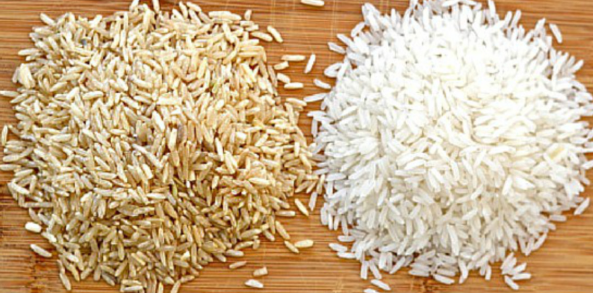
Rice is a versatile grain consumed by people around the world.
It serves as a staple food for many people, especially those living in Asia.
Rice comes in several colors, shapes and sizes, but the most popular are white and brown rice.
White rice is the most commonly consumed type, but brown rice is widely recognized as a healthier option.
Many people prefer brown rice for this reason.
All rice consists almost entirely of carbs, with small amounts of protein and practically no fat.
Brown rice is a whole grain. That means it contains all parts of the grain — including the fibrous bran, the nutritious germ and the carb-rich endosperm.
White rice, on the other hand, has had the bran and germ removed, which are the most nutritious parts of the grain.
This leaves white rice with very few essential nutrients, which is why brown rice is usually considered much healthier than white.
Brown Rice is Higher in Fiber, Vitamins and Minerals
Brown rice has a big advantage over white rice when it comes to nutrient content.
Brown rice has more fiber and antioxidants, as well as a lot more important vitamins and minerals.
White rice is mostly a source of "empty" calories and carbs with very few essential nutrients.
100 grams (3.5 ounces) of cooked brown rice provide 1.8 grams of fiber, whereas 100 grams of white provide only 0.4 grams of fiber.
Key nutritional differences
Here are a few key differences between white and brown rice. The exact nutritional components will vary depending on the rice manufacturer, so be sure to read the food label on any rice that you buy.
Fiber
Brown rice is generally higher in fiber than white rice. It typically provides 1 to 3 g more fiber than a comparable amount of white rice.
Although fiber is best known for constipation relief, it offers a number of other health benefits. It can help you:
- feel fuller faster, which can aid in weight management
- lower your cholesterol levels
- control your blood sugar levels, reducing your risk of diabetes
- reduce your risk of heart disease
- nourish your gut bacteria
Generally, men under the age of 50 need 38 g of fiber per day, and men who are 51 years or older need 30 g.
Women under the age of 50 typically need 25 g per day, and women who are 51 years or older need 21 g.
Your daily recommended amount of fiber is based on several factors, including age and caloric intake, so talk with your doctor if you are unsure of how much you need.
Manganese
Manganese is a mineral that is essential for energy production and antioxidant function. Brown rice is an excellent source of this nutrient, while white rice is not.
Selenium
Brown rice is a good source of selenium, which plays an integral role in thyroid hormone production, antioxidant protection, and immune function. Selenium also works with vitamin E to protect cells from cancer.
Magnesium
Unlike white rice, brown rice is typically a good source of magnesium. The average serving of cooked brown rice, about 1/2 cup, can provide around 11 percent of your daily recommended amount of magnesium.
Magnesium is necessary for many vital functions, including:
- blood coagulation
- muscle contraction
- cellular production
- bone development
The recommended daily intake of this important nutrient is determined by sex and age. Women who are pregnant or breastfeeding typically require a higher daily intake. The average adult needs between 270 and 400 mg daily.
Folate
Enriched white rice is a good source of folate. An average 1 cup serving can contain 195 to 222 micrograms (mcg) of folate, or about half of your daily recommended amount.
Folate helps your body make DNA and other genetic material. It also supports cell division. Although folate is an essential nutrient for everyone, it is especially vital for women who are pregnant or are planning to become pregnant.
The recommended daily value for most adults is around 400 mcg. Women who are pregnant should consume 600 mcg, and women who are breastfeeding should get 500 mcg.
Risks
Rice is known to be contaminated with arsenic, whether white, brown, organic, or conventional. Issued statement discouraging pregnant women and parents from using rice or rice cereals as the primary grain staple due to arsenic contamination. Arsenic is a heavy metal that the body accumulates over time and can not excrete. So it is prudent also for adults to eat a variety of foods and grains to limit their arsenic exposure in rice.
Nuts, seeds, and whole grains like brown rice also contain phytic acid, a substance that can bind to the minerals calcium, iron, and zinc. Some whole grains contain enough phytase, the enzyme required to break down phytic acid, while others like oats, brown rice, and legumes do not.
Because humans do not make phytase, soaking, fermenting, or sprouting of these foods can improve mineral absorption by reducing their phytic acid levels. White rice has lower levels of phytic acid due to processing.
Brown rice is generally more nutritious than white rice. It is higher in fiber, magnesium, and other nutrients, and it is not artificially enriched with nutrients like white rice is.
If you would like to add rice to your diet but are not sure if it is right for you, talk to your dietitian. They can go over the potential effects it may have on any existing health conditions and advise you on how to safely add it to your diet.
Your Health is Our Concern!
Mawuena Workartey/ Ghanahospitals.org